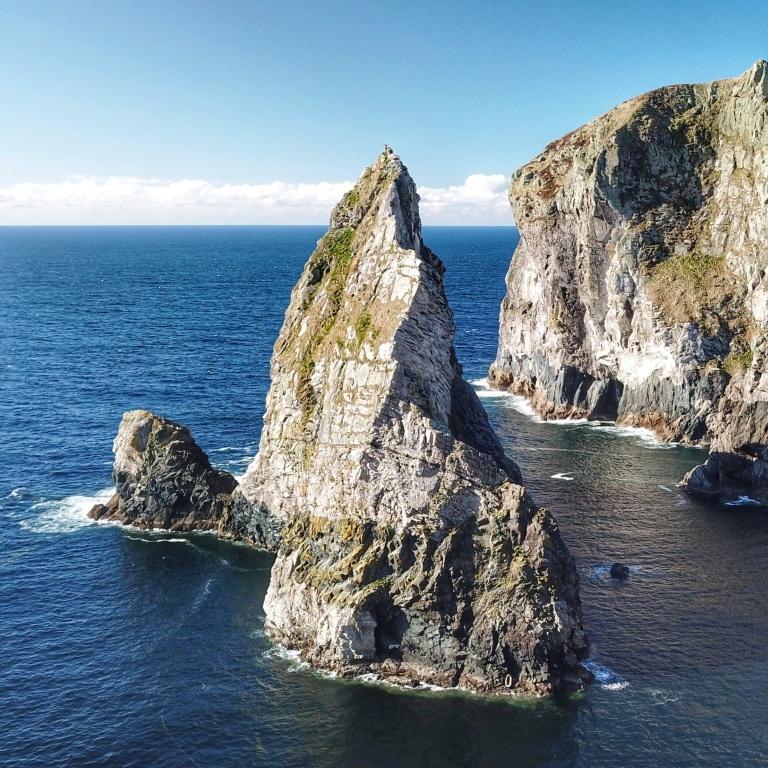Cnoc na Mara (Hill of the Sea) is an iconic 100 meter high sharks fin sea stack living in the southern shadow of Irelands highest sea stack Tormore Island. It is safe to say this stack represents all that is great about adventure climbing. It's impressive soaring 150m long landward arête provides one of the most rewarding and adventurous rock climbs in Ireland. It is easily an equal to the mighty Old Man of Hoy off the Orkney Islands in the north of Scotland.
Access is by a monsterous steep grassy descent followed by a 50m abseil to a storm beach at the entrance to Shambala. As you descent this steep slope, sitting out to sea, Cnoc na Mara grows with height as you descend reaching epic proportions as you get closer to to beach. Gaining the beach alone is an adventurous undertaking in it's own right and is an excellent taster off what is to come.

In summary to climb Cnoc na Mara, drive the 22-kilometre c class laneway from Ardara to the road end at An Port, the gateway to Ireland's last great wilderness. From here on foot, follow the clifftop path for approx 2 kilometres to an outstanding viewpoint overlooking Glenlough Bay, Irelands largest raised shingle storm beach. From this viewpoint descend the very steep grass/scree slope for 200 or so metres and abseil from the two peg belay to the Entrance to Shambala storm beach. From the beach, it is a 125-meter sea passage to the base of the stack. All the routes on the stack are climbed in four pitches with two return to sea level abseils.
1: Cnoc na Mara lives in one of the most remote places on mainland Ireland.
2: The grassy approach slopes are very steep to the raised shingle storm beach opposite the stack.
3: The nautical approach to the stack involves a 100 to 150-meter sea passage. (The coast here is very exposed to Atlantic swells)
4: The rock on the stack is good BUT your situation causes everything to appear a wee bit more atmospheric than it actually is.
5: The ropework on the stack requires a wee bit of thought as it is not conventional esp on the summit ridge pitch of the Landward Arete
6: 60 metre half ropes are best for the Landward Arete route as they save a stance on the summit ridge.
7: Pitch 3 is the crux pitch but the summit ridge it the mindblower.
Cnoc na Mara Freesolo
Cnoc na Mara Summit View
The above are just a few thoughts on attempting this stack, it's location out to sea from the Entrance to Shambalha storm beach is outrageous. It is always worth bearing in mind that the actual climbing is by far the easiest part of your day with the logistics of actually getting to the base of the stack as the crux of your day.
In July 2008, Cnoc na Mara's summit first got stood on when Iain Miller, Alan Tees and Marty Mcguigan climbed the landward arête at VS and in four pitches with two abseils back to sea level.
In April 2009 a second route, "A Puffin Too Far," was climbed on the stack by Simon Tait and Iain Miller, this route took the central groove up the seaward face at VS 4c, again four pitches and two abseils.
In July 2011 a team of 10 Irish climbers climbed the original Landward Atête in the stacks first (and only) mass ascent. During this mass ascent day Wolfgang Schuessler, Ambrose Flynn ventured onto the seaward face and climbed "Euro Trash," taking the groove system to the left of "A Puffin Too Far" at VS 4b. They descended by the landward arete and made the first traverse of the stack.
In June 2015, Iain Miller paddled from An Port and free soloed the landward arête and so Cnoc na Mara got its first free solo.
In the years 2011 to 2015 I have guided 6 more parties of Irish and American climbers to the summit of the stack by the landward arête, in total 24 people have stood on the summit to date, 3rd November 2015.
"Living along the western seaboard of County Donegal live 100 guardians of an ancient and little known world. Sculptured by the pounding heart of the wild Atlantic Ocean over thousands of our lifetimes these towering rock sentinels stand guard at the outer edge of our distant shores. Marking the boundary between the moving and the static, these gothic leviathans are the last remains of a time long forgotten.
Imagine travelling 20km on single track laneway from the nearest main road followed by a 4 km walk over Ireland’s last great wilderness to visit the most remote point of land on mainland Ireland. From here standing on the summit of this near 1000 foot high sea cliff overlooking the distant edge of the further, we descend to sea level to arrive on outstandingly beautiful storm beaches in the most remote, isolated and atmospheric locations in the country. We launch from the shore to cross the open ocean and land on the bases of these waves sculptured rock towers. We then climb these lonely towers to arrive on a pristine pinpoint summit far from anywhere in the real world.
Standing on an isolated summit over 100 metres above the ocean, 500 metres from the nearest point of land on mainland Ireland and over 20 km from the nearest main road can easily be described as a truly spiritual experience. You are now standing on a summit that has been visited and stood on fewer times than the surface of the moon."